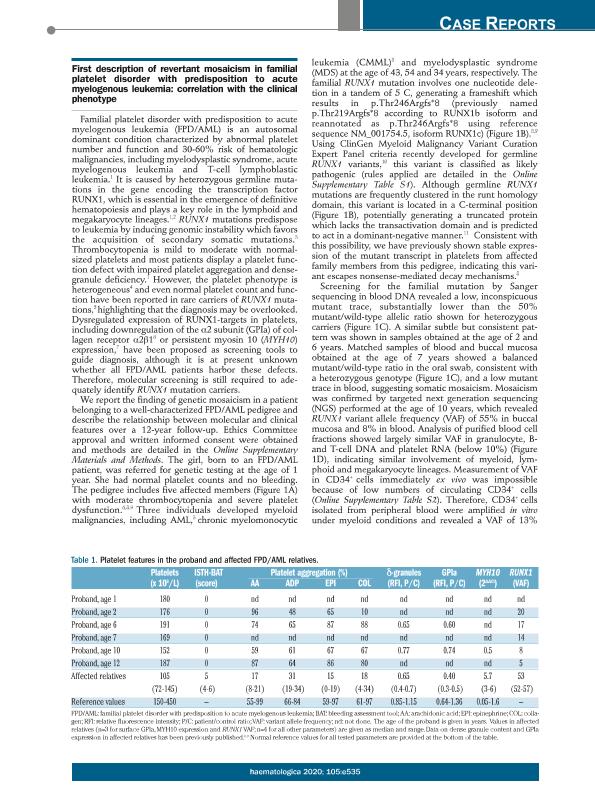Artículo
First description of revertant mosaicism in familial platelet disorder with predisposition to acute myelogenous leukemia: correlation with the clinical phenotype
Glembotsky, Ana Claudia ; Marin Oyarzún, Cecilia Paola
; Marin Oyarzún, Cecilia Paola ; de Luca, Geraldine
; de Luca, Geraldine ; Marzac, Christophe; Auger, Nathalie; Goette, Nora Paula
; Marzac, Christophe; Auger, Nathalie; Goette, Nora Paula ; Marta, Rosana Fernanda
; Marta, Rosana Fernanda ; Raslova, Hana; Heller, Paula Graciela
; Raslova, Hana; Heller, Paula Graciela
 ; Marin Oyarzún, Cecilia Paola
; Marin Oyarzún, Cecilia Paola ; de Luca, Geraldine
; de Luca, Geraldine ; Marzac, Christophe; Auger, Nathalie; Goette, Nora Paula
; Marzac, Christophe; Auger, Nathalie; Goette, Nora Paula ; Marta, Rosana Fernanda
; Marta, Rosana Fernanda ; Raslova, Hana; Heller, Paula Graciela
; Raslova, Hana; Heller, Paula Graciela
Fecha de publicación:
10/2020
Editorial:
Ferrata Storti Foundation
Revista:
Haematologica
ISSN:
1592-8721
Idioma:
Inglés
Tipo de recurso:
Artículo publicado
Clasificación temática:
Resumen
Familial platelet disorder with predisposition to acute myelogenous leukemia (FPD/AML) is an autosomal dominant condition characterized by abnormal platelet number and function and 30-60% risk of hematologic malignancies, including myelodysplastic syndrome, acute myelogenous leukemia and T-cell lymphoblastic leukemia.1 It is caused by heterozygous germline muta- tions in the gene encoding the transcription factor RUNX1, which is essential in the emergence of definitive hematopoiesis and plays a key role in the lymphoid and megakaryocyte lineages.1,2 RUNX1 mutations predispose to leukemia by inducing genomic instability which favors the acquisition of secondary somatic mutations.3 Thrombocytopenia is mild to moderate with normal- sized platelets and most patients display a platelet func- tion defect with impaired platelet aggregation and dense- granule deficiency.1 However, the platelet phenotype is heterogeneous4 and even normal platelet count and func- tion have been reported in rare carriers of RUNX1 muta- tions,5 highlighting that the diagnosis may be overlooked. Dysregulated expression of RUNX1-targets in platelets, including downregulation of the α2 subunit (GPIa) of col- lagen receptor α2b16 or persistent myosin 10 (MYH10) expression,7 have been proposed as screening tools to guide diagnosis, although it is at present unknown whether all FPD/AML patients harbor these defects. Therefore, molecular screening is still required to ade- quately identify RUNX1 mutation carriers.We report the finding of genetic mosaicism in a patient belonging to a well-characterized FPD/AML pedigree and describe the relationship between molecular and clinical features over a 12-year follow-up.
Archivos asociados
Licencia
Identificadores
Colecciones
Articulos(IDIM)
Articulos de INST.DE INVEST.MEDICAS
Articulos de INST.DE INVEST.MEDICAS
Citación
Glembotsky, Ana Claudia; Marin Oyarzún, Cecilia Paola; de Luca, Geraldine; Marzac, Christophe; Auger, Nathalie; et al.; First description of revertant mosaicism in familial platelet disorder with predisposition to acute myelogenous leukemia: correlation with the clinical phenotype; Ferrata Storti Foundation; Haematologica; 105; 10; 10-2020; 535-539
Compartir
Altmétricas



